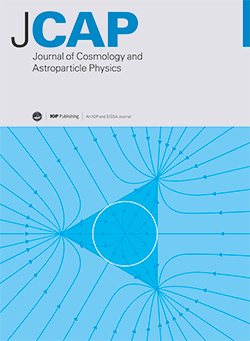Cosmology of single species hidden dark matter
IF 5.3
2区 物理与天体物理
Q1 ASTRONOMY & ASTROPHYSICS
Journal of Cosmology and Astroparticle Physics
Pub Date : 2025-05-22
DOI:10.1088/1475-7516/2025/05/077
引用次数: 0
Abstract
Cosmology and astrophysics provide various ways to study the properties of dark matter even if they have negligible non-gravitational interactions with the Standard Model particles and remain hidden. We study a type of hidden dark matter model in which the dark matter is completely decoupled from the Standard Model sector except gravitationally, and consists of a single species with conserved comoving particle number and conserved comoving entropy. This category of hidden dark matter includes models that act as warm dark matter but is more general. In particular, in addition to having an independent temperature from the Standard Model sector, it includes cases in which dark matter is in its own kinetic equilibrium or is free-streaming, obeys fermionic or bosonic statistics, and processes a chemical potential that controls the particle occupation number. While the usual parameterization using the free-streaming scale or the particle mass no longer applies, we show that all cases can be well approximated by a set of functions parameterized by only one parameter as long as the chemical potential is nonpositive: the characteristic scale factor at the time of the relativistic-to-nonrelativistic transition. We study the constraints from Big Bang Nucleosynthesis, the cosmic microwave background, the Lyman-α forest, and the smallest halo mass. We show that the most significant phenomenological impact is the suppression of the small-scale matter power spectrum — a typical feature when the dark matter has a velocity dispersion or pressure at early times. So far, the Lyman-α forest and the small dark matter halo population provide the strongest constraints, limiting the transition redshift to be larger than ∼6.2×107.单一物种隐藏暗物质的宇宙学
宇宙学和天体物理学提供了各种方法来研究暗物质的性质,即使它们与标准模型粒子的非引力相互作用可以忽略不计,并且仍然隐藏着。我们研究了一种隐藏暗物质模型,在这种模型中,暗物质除了引力之外与标准模型扇区完全解耦,并且由具有守恒的共动粒子数和守恒的共动熵的单一物质组成。这类隐藏的暗物质包括像热暗物质一样的模型,但更普遍。特别是,除了具有独立于标准模型扇区的温度外,它还包括暗物质处于自身动力学平衡或自由流动的情况,服从费米子或玻色子统计,并处理控制粒子占据数的化学势。虽然通常使用自由流动尺度或粒子质量的参数化不再适用,但我们表明,只要化学势是非正的,所有情况都可以用一组仅由一个参数参数化的函数来很好地近似:相对论性到非相对论性转变时的特征尺度因子。我们研究了来自大爆炸核合成、宇宙微波背景、莱曼α森林和最小光晕质量的约束。我们发现,最显著的现象影响是对小尺度物质功率谱的抑制——这是暗物质在早期具有速度色散或压力时的典型特征。到目前为止,莱曼α森林和小暗物质晕群提供了最强的约束,限制了跃迁红移大于6.2×107。
本文章由计算机程序翻译,如有差异,请以英文原文为准。
求助全文
约1分钟内获得全文
求助全文
来源期刊

Journal of Cosmology and Astroparticle Physics
地学天文-天文与天体物理
CiteScore
10.20
自引率
23.40%
发文量
632
审稿时长
1 months
期刊介绍:
Journal of Cosmology and Astroparticle Physics (JCAP) encompasses theoretical, observational and experimental areas as well as computation and simulation. The journal covers the latest developments in the theory of all fundamental interactions and their cosmological implications (e.g. M-theory and cosmology, brane cosmology). JCAP''s coverage also includes topics such as formation, dynamics and clustering of galaxies, pre-galactic star formation, x-ray astronomy, radio astronomy, gravitational lensing, active galactic nuclei, intergalactic and interstellar matter.
 求助内容:
求助内容: 应助结果提醒方式:
应助结果提醒方式:


